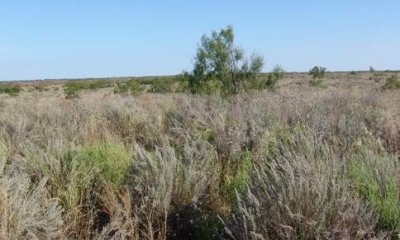
Loamy Sand 19-26" PZ
Scenario model
Current ecosystem state
Select a state
Management practices/drivers
Select a transition or restoration pathway
-
Transition T1A
Absence of disturbance and natural regeneration over time, may be coupled with excessive grazing pressure
More details -
Restoration pathway R2A
Adequate rest from defoliation, followed by reintroduction of historic disturbance regimes
More details -
Transition T2A
Absence of disturbance and natural regeneration over time, may be coupled with excessive grazing pressure
More details -
Transition T2B
Absence of disturbance and natural regeneration over time, may be coupled with excessive grazing pressure
More details -
Restoration pathway R3A
Adequate rest from defoliation and removal of woody canopy
More details -
Restoration pathway R4A
Adequate rest from defoliation and removal of woody canopy
More details -
No transition or restoration pathway between the selected states has been described
Target ecosystem state
Select a state
Description
The Tallgrass/Midgrass Dominant Community is a balanced mixture of tallgrasses such as little bluestem and sand bluestem and occasionally switchgrass and sand lovegrass; midgrasses such as sideoats grama, dropseeds, and silver bluestem; a good diversity of forbs such as Illinois bundleflower, dotted gayfeather, catclaw sensitivebriar (Mimosa microphylla), prairie clover, and bushsunflower; scattered woody shrubs such as sand sagebrush, skunkbush sumac, yucca, catclaw mimosa and sand shinnery or Havard oak. Scattered hardwood trees are present, mainly hackberry and western soapberry.
The Mid/Tallgrass Dominant Community (1.2) has a mixture of mid and tallgrasses such as sideoats grama, little bluestem, and lovegrass species. This site also has a good diversity of forbs and shrubs/vines such as bundleflower, ragweed, prairie clover, sand sagebrush, skunkbush, yucca, and sand shinnery oak. Scattered trees such as hackberry and western soapberry are also present in this community.
Submodel
Description
The Midgrass/Shrub Community is dominated by midgrasses such as sideoats grama and sand dropseed along with forbs such as western ragweed. Woody shrubs such as sand sagebrush and Havard or sand shinnery oak increase to more than 25% of the annual forage production. Annual forbs such as wild buckwheat and weak perennial grasses such as red and gummy lovegrass can increase. There is a decrease of ground cover, decreased annual herbaceous production, and decreased vigor of tallgrasses such as little bluestem.
Submodel
Description
The Midgrass/Shortgrass/Shrubs/Forb Community (3.1) is dominated by weedy forbs, mainly western ragweed, camphorweed and annuals such as wild buckwheat. Scattered perennial grasses found in this community consisted of mostly perennial threeawn, dropseeds, fringed signalgrass, blue grama, hairy grama, buffalograss and annuals such as red lovegrass, gummy lovegrass, and sandbur. Woody shrubs compose approximately 25% of the composition. Some scattered honey mesquite and pricklypear may increase in the less sandy portions of this site with sand sagebrush and Havard oak comprising most of the shrub population.
Submodel
Description
The Shrub/Shortgrass State consists of forbs and woody shrub dominating the site, which occurs with sand sagebrush being the dominant species. There are some shortgrasses present as well. In time, tallgrasses will all but disappear allowing lower successional grasses such as fringed signalgrass and forbs like western ragweed and annual forbs to become more numerous. In some cases, mesquite and pricklypear cactus will occupy portions of the site where soil texture is slightly less in sand content.
Submodel
Mechanism
With heavy continuous grazing, no fires, and no brush management implemented, the Grassland State will transition into the Midgrass/Shrubland State.
Mechanism
With the implementation of Prescribed Grazing, Brush Management, and Prescribed Burning conservation practices, the Midgrass/Shrubland State can be restored back to the Grassland State.
Relevant conservation practices
| Practice | External resources |
|---|---|
|
Brush Management |
|
|
Prescribed Burning |
|
|
Prescribed Grazing |
Mechanism
With heavy continuous grazing, no brush management, brush invasion, and no fires, the Midgrass/Shrubland State will transition into the Mixed-grass/Forb State.
Mechanism
With heavy continuous grazing, no brush management, brush invasion and no fires, the Midgrass/Shrubland State will transition into the Shrub/Shortgrass State.
Mechanism
The Mixed-grass/Forb State can be restored back to the Midgrass/Shrubland State with the application of conservation practices such as Prescribed Grazing, Brush Management, Pest Management, and Prescribed Burning.
Relevant conservation practices
| Practice | External resources |
|---|---|
|
Brush Management |
|
|
Prescribed Burning |
|
|
Prescribed Grazing |
|
|
Integrated Pest Management (IPM) |
Mechanism
With the implementation of various conservation practices such as Prescribed Grazing, Brush Management and Prescribed Burning, the Shrub/Shortgrass State can be restored back to the Midgrass/Shrubland State.
Relevant conservation practices
| Practice | External resources |
|---|---|
|
Brush Management |
|
|
Prescribed Burning |
|
|
Prescribed Grazing |
|
|
Integrated Pest Management (IPM) |
Model keys
Briefcase
Add ecological sites and Major Land Resource Areas to your briefcase by clicking on the briefcase (![]() ) icon wherever it occurs. Drag and drop items to reorder. Cookies are used to store briefcase items between browsing sessions. Because of this, the number of items that can be added to your briefcase is limited, and briefcase items added on one device and browser cannot be accessed from another device or browser. Users who do not wish to place cookies on their devices should not use the briefcase tool. Briefcase cookies serve no other purpose than described here and are deleted whenever browsing history is cleared.
) icon wherever it occurs. Drag and drop items to reorder. Cookies are used to store briefcase items between browsing sessions. Because of this, the number of items that can be added to your briefcase is limited, and briefcase items added on one device and browser cannot be accessed from another device or browser. Users who do not wish to place cookies on their devices should not use the briefcase tool. Briefcase cookies serve no other purpose than described here and are deleted whenever browsing history is cleared.
Ecological sites
Major Land Resource Areas
The Ecosystem Dynamics Interpretive Tool is an information system framework developed by the USDA-ARS Jornada Experimental Range, USDA Natural Resources Conservation Service, and New Mexico State University.






